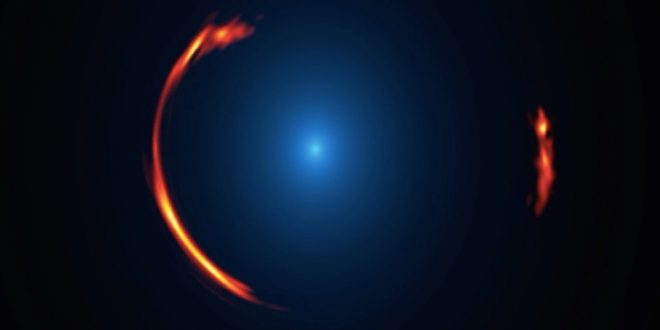New analysis reveals a dwarf dark galaxy which has been distorted by the gravity of a foreground galaxy.
Astronomers have found a dwarf dark galaxy hidden in Atacama Large Millimeter/Submillimeter Array (ALMA) telescope’s image.
In 2014, as part of ALMA’s Long Baseline Campaign, astronomers studied a variety of astronomical objects to test the telescope’s new high-resolution capabilities. One of these experimental images was that of an Einstein ring, which was produced by a massive foreground galaxy bending the light emitted by another galaxy nearly 12 billion light-years away.
This phenomenon, called gravitational lensing, was predicted by Einstein’s theory of general relativity, and it offers a powerful tool for studying galaxies that are otherwise too distant to observe. It also sheds light on the properties of the nearby lensing galaxy because of the way its gravity distorts and focuses light from more distant objects.
In a new paper accepted for publication in the Astrophysical Journal, astrophysicist Yashar Hezaveh at Stanford and his team explain how detailed analysis of this image of a galaxy called SDP.81 uncovered signs of a hidden dwarf dark galaxy in the halo of a the more nearby galaxy.
“We can find these invisible objects in the same way that you can see rain droplets on a window: You know they are there because they distort the image of the background objects,” explained Hezaveh. In the case of a raindrop, the image distortions are caused by refraction, but here similar distortions are generated by the gravitational influence of dark matter, according to Einstein’s theory of relativity.
Current theories suggest that dark matter, which makes up 80 percent of the mass of the universe, is made of as-yet-unidentified particles that don’t interact with visible light or other forms of electromagnetic radiation. Dark matter does, however, have appreciable mass, so it can be identified by its gravitational influence.
For their analysis, the researchers harnessed thousands of computers working in parallel for many weeks, including the National Science Foundation’s most powerful supercomputer, Blue Waters, to search for subtle anomalies that had a consistent and measurable counterpart in each “band” of radio data. From these combined computations, the researchers were able to piece together an unprecedented understanding of the lensing galaxy’s halo, the diffuse and predominantly star-free region around the galaxy, and discovered a distinctive clump, less than one-thousandth the mass of the Milky Way.
Because of its relationship to the larger galaxy, its estimated mass and lack of an optical counterpart, the astronomers believe this gravitational anomaly may be caused by an extremely faint, dark-matter dominated satellite of the lensing galaxy. According to theoretical projections, most galaxies should be brimming with similar dwarf galaxies and other companion objects. Detecting them, however, has proven challenging. Even in our own Milky Way, astronomers can identify only about 40 of the thousands of satellite dwarfs that are predicted to be present.
Computer models of the evolution of the universe indicate that if the number of small dark matter clumps around distant galaxies, like the one detected here, is significantly lower than predictions, this would imply that the dark matter particles have a warm temperature.
Risa Wechsler, an associate professor of physics at Stanford, and graduate student Yao-Yuan Mao used these compter simulations to show that so far this detection is consistent with the predictions of the cold dark matter theoretical model. More observations are needed, however, to definitively rule out the possibility of a warm temperature for dark matter.
“This detection is very exciting – it shows that we finally have a tool to find these dwarf satellites efficiently in a way that was not possible before,” said Wechsler. “Now we need to look at other galaxies to hopefully find more of these small dark halos to have a statistically significant test of the cold dark matter predictions.”
The finding is an exciting demonstration of the power of ALMA, said astrophysicist Roger Blandford, the Luke Blossom Professor in the School of Humanities and Science at Stanford, who was involved in the research. “This discovery proves that ALMA can be used to provide valuable new insights into the physics of dark matter.”
Agencies/Canadajournal

 Canada Journal – News of the World Articles and videos to bring you the biggest Canadian news stories from across the country every day
Canada Journal – News of the World Articles and videos to bring you the biggest Canadian news stories from across the country every day

